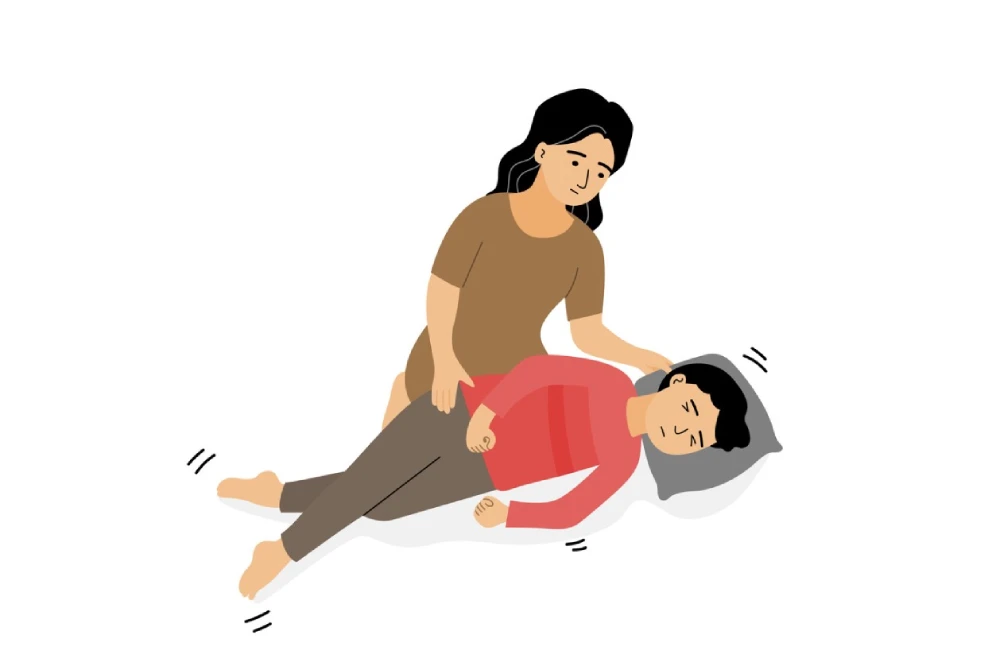Epilepsy affects millions of people worldwide, yet myths and misconceptions still surround this neurological disorder.
Imagine you’re at a coffee shop when a person nearby suddenly freezes, their gaze locked in a blank stare. A few seconds later, they regain awareness, confused but unharmed.
This could be an absence seizure, a form of epilepsy often mistaken for daydreaming. Understanding epilepsy, its symptoms, treatments, and daily care is crucial for improving the quality of life for those affected.
Whether you or a loved one is living with epilepsy, this guide will help you navigate the journey toward better health and well-being.
Understanding Epilepsy and Seizures
Epilepsy is a complex neurological condition that affects brain function in diverse ways.
Before diving into the specifics of symptoms and treatment, it’s important to understand what epilepsy is and how it differs from other disorders that may present with similar symptoms.
Epilepsy – A Brain Disorder Causing Abnormal Electrical Activity
Epilepsy is a chronic neurological disorder that causes recurrent, unprovoked seizures due to abnormal electrical activity in the brain.
Unlike occasional seizures that can be triggered by fever, injury, or illness, epilepsy is a long-term condition requiring medical management.
Seizures vary widely, from brief lapses in awareness to full-body convulsions. The severity and frequency of these episodes depend on the type of epilepsy and the brain areas involved.
Differences Between Epilepsy and Other Neurological Disorders
While epilepsy is a well-known seizure disorder, not all seizures indicate epilepsy. Other neurological conditions can mimic epilepsy symptoms, such as:
- Migraines
- Fainting spells (syncope)
- Psychogenic non-epileptic seizures (PNES)
Unlike epilepsy, which stems from abnormal brain activity, PNES is often linked to psychological stress. This distinction is critical for accurate diagnosis and treatment.

Who Can Be Affected With Epilepsy in Canada?
Epilepsy is a condition that knows no boundaries—it can affect individuals regardless of age, gender, or background.
Understanding who is most at risk can help with early detection, management, and support for those living with the condition.
Epilepsy Can Occur at Any Age and in Any Background
Epilepsy affects people of all ages, races, and socioeconomic backgrounds. While it can develop at any stage of life, it is most commonly diagnosed in childhood and later adulthood.
Some individuals may outgrow epilepsy, while others manage it throughout their lives with medication and lifestyle adjustments.
Key Statistics in Canada and Globally
According to Epilepsy Newfoundland and Labrador, approximately 300,000 Canadians live with a seizure disorder, with about 14,000 new cases diagnosed annually.
Globally, the World Health Organization (WHO) estimates that over 50 million people are affected by epilepsy, which makes it one of the most common neurological disorders worldwide.
How Epilepsy Differs from Other Seizure Disorders
Not all seizures indicate epilepsy, and understanding the distinction is essential for proper diagnosis and treatment.
Some seizures occur due to temporary conditions, such as high fever, head trauma, infection or metabolic imbalances. Others are part of a chronic neurological disorder requiring long-term management.
For an epilepsy diagnosis, multiple criteria must be met, such as two unprovoked seizures more than 24 hours apart, among other factors.
The Types & Spectrum of Seizures
Seizures can manifest in various ways, from mild episodes of confusion to full-body convulsions.
Understanding the different types of seizures helps with diagnosis, treatment, and managing epilepsy effectively.
According to Epilepsy Canada, seizures can be grouped into two broad categories: focal seizures and generalized seizures.
- Focal (Partial) Seizures: Affecting approximately 60% of people diagnosed with epilepsy, focal seizures originate in a specific area of the brain and may or may not involve loss of consciousness. Symptoms depend on the affected brain region and can include muscle twitching, sensory changes, or déjà vu sensations.
- Generalized Seizures: These involve widespread brain activity and typically result in loss of consciousness. Common types include tonic-clonic seizures (violent muscle contractions) and absence seizures (brief lapses in awareness).
Apart from these two main categories, seizures may also be classified as having atypical and complex presentations. This often includes seizures that present with unusual symptoms, such as temporary paralysis, hallucinations, or uncontrolled emotions, making diagnosis challenging.

Recognizing Epilepsy & Seizure Signs & Symptoms
Identifying the signs of epilepsy is crucial for timely diagnosis and effective management. While some symptoms are immediately recognizable, others can be subtle and easily overlooked.
Common Seizure Symptoms
- Muscle jerking or twitching
- Muscles becoming rigid
- Loss of consciousness
- Confusion and disorientation
- Temporary staring episodes
Less Noticeable Seizure Symptoms
- Sudden mood changes
- Déjà vu sensations
- Fear, panic, or anxiety
Seizure Triggers and Warning Signs
- Sleep deprivation
- Stress and anxiety
- Flashing lights (photosensitivity)
- Alcohol consumption
- Infections and fever
Epilepsy and Seizure Causes and Risk Factors
Understanding the causes and risk factors of epilepsy can help individuals take preventive measures where possible and seek timely medical intervention.
While some factors are genetic, others are linked to brain injuries, environmental influences, or developmental conditions.
Genetic Factors
Some epilepsy syndromes have a hereditary component, meaning a family history of epilepsy can increase the likelihood of developing the condition.
Certain gene mutations can also make individuals more susceptible to seizures, although genetics alone may not always determine the onset of epilepsy.
Brain Injuries and Diseases
Traumatic brain injuries, strokes, brain tumours, and infections such as meningitis or encephalitis can lead to epilepsy.
Any significant damage to the brain’s structure can disrupt normal electrical activity, increasing seizure risk. In some cases, epilepsy can develop years after an initial brain injury.
Unknown and Environmental Factors
Factors such as prenatal exposure to toxins, complications during birth, or severe fevers in childhood may contribute to the development of epilepsy.
Additionally, environmental influences, such as air pollution and exposure to heavy metals, are also being studied for their potential impact on seizure disorders.
However, according to Epilepsy Canada, it’s estimated that the exact cause of epilepsy remains unidentified in roughly 50% of patients.
Age and Development
Children and older adults are at higher risk of developing epilepsy.
While epilepsy may arise in children due to congenital conditions, genetic predisposition, or perinatal injuries, older adults typically experience an onset due to age-related conditions such as strokes, Alzheimer’s disease, and other neurodegenerative disorders.
Epilepsy and Seizure Diagnosis and Medical Evaluation
Accurate diagnosis is the first step in managing epilepsy effectively.
Because seizures can stem from various causes, a thorough medical evaluation is necessary to differentiate epilepsy from other conditions and ensure the right treatment approach.
To support this, patients are often recommended to keep a seizure diary to help doctors identify patterns and triggers.
Medical Tests for Epilepsy
- Electroencephalogram (EEG): Measures brain activity
- Imaging (MRI, CT scans): Detects structural abnormalities
How Doctors Differentiate Epilepsy from Other Conditions
Seizures must be distinguished from fainting spells, migraines, or psychological conditions, as each presents with unique causes and treatment approaches.
Fainting spells, or syncope, often result from a temporary drop in blood pressure, while migraines can cause neurological symptoms such as aura but do not involve abnormal electrical activity in the brain.
Psychological conditions, including psychogenic non-epileptic seizures (PNES), are often triggered by emotional stress rather than abnormal brain function, requiring different diagnostic methods and treatment strategies.
Epilepsy Treatment Options & Management Strategies
Managing epilepsy requires a combination of medical treatment, lifestyle adjustments, and alternative approaches tailored to each individual.
Effective treatment plans help reduce seizure frequency, improve overall well-being, and allow individuals to lead fulfilling lives.
Medications for Epilepsy
Anti-epileptic drugs (AEDs) are the most common treatment for epilepsy, helping to control seizures in about 50-80% of patients, according to the Canadian Epilepsy Alliance.
Common AEDs include:
While these medications are effective, they may have side effects such as fatigue, dizziness, and changes in weight, requiring close monitoring by a healthcare professional.
Lifestyle Adjustments for Brain Health
In addition to medication, maintaining brain health through lifestyle changes can significantly impact seizure control.
Prioritizing sleep hygiene ensures the brain functions optimally, while stress management techniques, such as meditation and deep breathing, can help prevent stress-induced seizures.
A balanced diet rich in nutrients supports overall neurological health and can play a role in seizure prevention.
Alternative and Complementary Therapies
Some individuals explore alternative treatments to complement their medical therapy. The ketogenic diet, a high-fat, low-carbohydrate eating plan, has shown effectiveness in reducing seizures in some cases.
Medical cannabis, where legally available, is also being studied for its potential benefits in epilepsy management.
However, consultation with a healthcare professional is essential before incorporating these therapies.
Monitoring, Regular Checkups, and Adjustments
Epilepsy treatment requires ongoing monitoring to assess medication effectiveness and adjust dosages when necessary.
Regular checkups with a healthcare provider ensure that treatment plans remain optimized and that any new symptoms or side effects are addressed promptly.

Emergency Response and Seizure First Aid
Seizures can be unpredictable, but knowing how to respond effectively can make a significant difference. Whether you’re assisting a loved one or a stranger, understanding the proper seizure first aid steps ensures safety and minimizes risk.
What to Do During a Seizure
- Stay calm
- Time the seizure
- Protect from injury
Seizure First Aid: Do’s and Don’ts
Knowing what to do during a seizure can prevent injury and provide reassurance to the individual experiencing it. The following guidelines highlight key actions to take and what to avoid during a seizure.
Do:
- Cushion the person’s head with something soft to prevent head injury.
- Turn the person on their side to help keep the airway clear.
- Time the seizure and note its duration to provide accurate information to healthcare providers.
- Stay with the person and provide reassurance as they regain consciousness.
- Remove nearby sharp or hard objects to reduce the risk of injury.
Don’t:
- Do not put anything in the person’s mouth. This can cause choking or damage to their teeth.
- Do not restrain their movements. Allow the seizure to run its course while keeping the person safe.
- Do not try to give water, food, or medication until the person is fully alert and conscious.
- Do not panic. Remaining calm will help others around you respond appropriately.
By following these do’s and don’ts, you can assist someone experiencing a seizure safely and effectively.
When to Call for Emergency Help
- Seizure lasts longer than 5 minutes
- Repeated seizures without recovery
Talk To Your Local PharmaChoice Pharmacist To Learn More About Living With Epilepsy
Understanding epilepsy and seizures empowers individuals to manage symptoms effectively. While epilepsy poses challenges, proper treatment and lifestyle modifications can significantly improve quality of life.
Need expert guidance on managing epilepsy? Visit your local PharmaChoice pharmacy today for personalized advice, medication support, and community-focused care.



